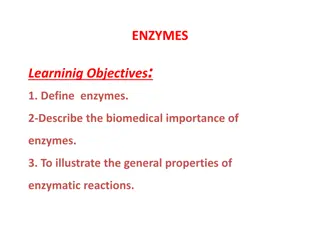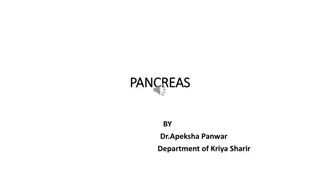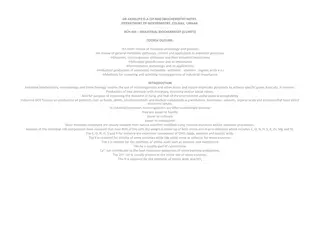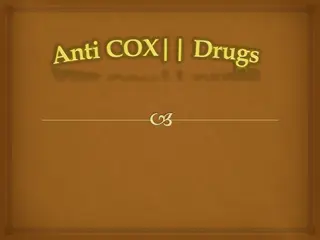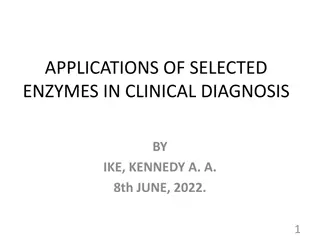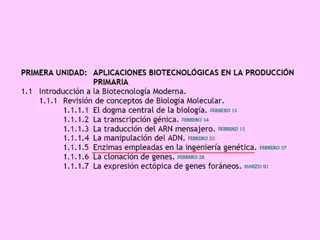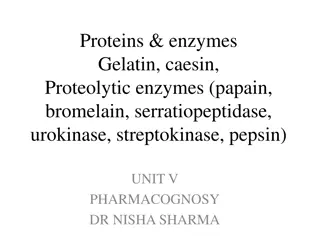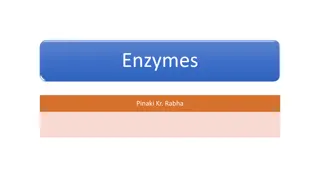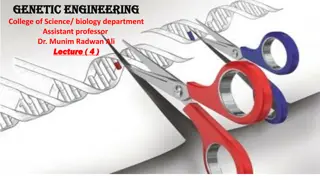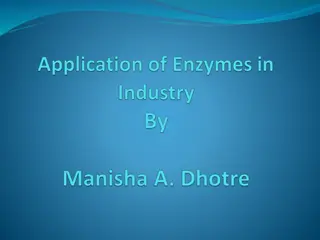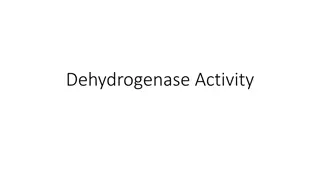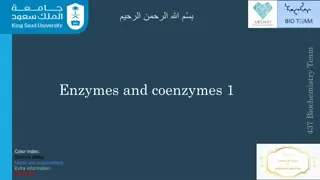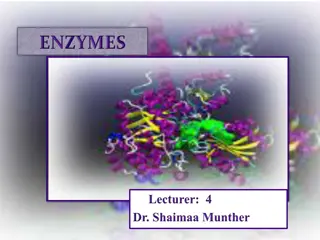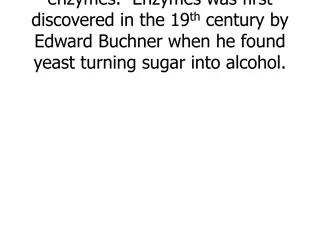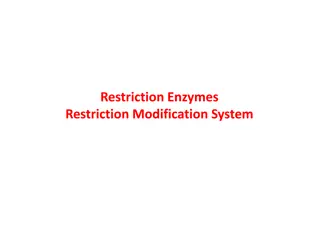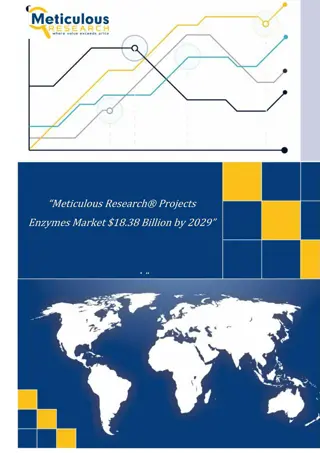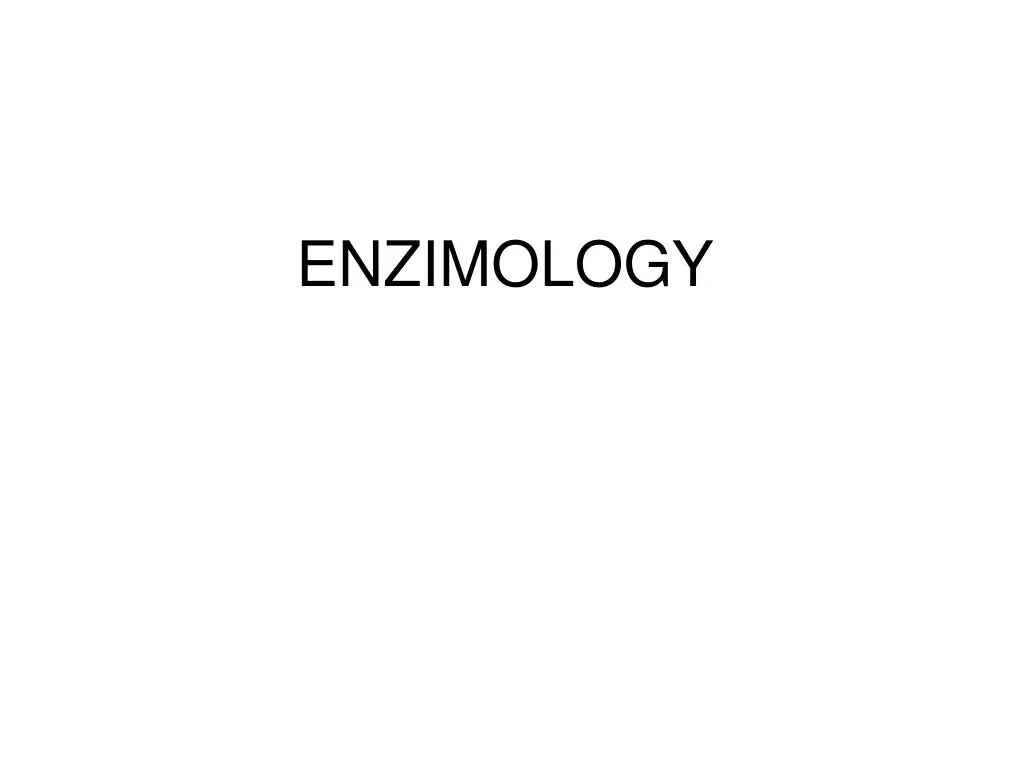
Understanding Enzymology and Chemical Reactions
Explore the world of enzymology, spontaneous and non-spontaneous reactions, free energy in chemical reactions, catalyzator models, enzymatic acceleration, coupled reactions, and the role of enzymes in accelerating reactions by lowering activation energy. Learn about coupled reactions like glucose phosphorylation and ATP hydrolysis, the importance of binding sites, active sites, substrates, and products in enzymatic reactions.
Download Presentation

Please find below an Image/Link to download the presentation.
The content on the website is provided AS IS for your information and personal use only. It may not be sold, licensed, or shared on other websites without obtaining consent from the author. If you encounter any issues during the download, it is possible that the publisher has removed the file from their server.
You are allowed to download the files provided on this website for personal or commercial use, subject to the condition that they are used lawfully. All files are the property of their respective owners.
The content on the website is provided AS IS for your information and personal use only. It may not be sold, licensed, or shared on other websites without obtaining consent from the author.
E N D
Presentation Transcript
Spontaneous or non-spontaneous The direction of the reactions determined by the direction of decrease of the free enthalpy G < 0 exergonic G > 0 endergonic A + B C + D
Free energy of chemical reactions A + B C + D [ ] [ ] C D = + ln G G RT [ ] [ ] A B G = : 0 In equilbrium [ ] [ ] C [ D = = 3 , 2 ln lg G RT K ] [ ] A B If K=1, then G = 0
Enzymatic acceleration of chemical reactions by decreasing the activation energy
Coupled reactions Termodinamically favored and non favored reactions Exergonic reactions (with negative G): spontaneous, occur without any energy investment Endergonic reactions (with positive G): do not occur spontaneously It can occur if an exergonic reaction is coupled to it and the cumulative G is negative
Enzymes Catalizators: -Lowering the activation energy -Don t change the equilibra or the free-energy change -Affect (accelerate) reaction rates -(High) specificity Mostly proteins (some of them are RNA-s) Coenzymes, prosthetic groups, metal ions
Coupled reaction of glucose phosphorylation and ATP hydrolysis by hexokinase File:Hexokinase-glucose.png
Binding site, active site Active site: a pocket on the enzyme, where the enzyme- catalyzed reaction takes place Substrate: The molecule that is bound in the active site and acted upon by the enzyme
Substrates and products Binding site, active site
Specific enzyme catalysis of the chosen reaction
Formation of enzyme-substrate complex The lock-and key theory: the substrate is exactly fits into the pocket of the enzyme, just like the key into the lock. Emil Fischer 1890
Formation of enzyme-substrate complex Induced fit theory: the binding of the substrate induce a change in the protein structure of the enzyme Koshland1958
Formation of enzyme-substrate complex The fluctuation fit model substrate active site inactive site
Enzyme Kinetics The rate of an enzymatic reaction and how it changes in response to changes in experimental parameters Key factor affecting the rate: concentration of substrate, [S] Enzyme concentration: ~ nanomolar quantities [S]: milimolar (five or six orders of magnitude higher). If only the beginning of the reaction is monitored (often the first 60 seconds or less), changes in [S] can be limited to a few percent and [S] can be regarded as constant. V0can then be explored as a function of [S], which is adjusted by the investigator.
At relatively low [S]: V0increases almost linearly with an increase of [S]. At higher [S]: V0increases by smaller and smaller amounts in response to increases of [S]. Finally, a point is reached beyond which increases in V0are vanishingly small as [S] increases. This plateau-like V0region is close to the maximum velocity, Vmax.
How many letters can be delivered by four postmen in an hour? The conditions are same.
5 4.5 vmax3= k2E03 4 3.5 reakci sebess g 3 2.5 velocity vmax2= k2E02 2 1.5 1 vmax1= k2E01 0.5 0 0 5 10 15 szubsztr tkoncentr ci concentration of substrate
What do the kinetical parameters tell us? vmax: It is proportional with the amount of enzyme. Essentially it gives the activity of the enzyme. It serves information on the amount of enzyme. It depends on the amount of enzyme (protein), it is not an enzyme feature 5 4.5 vmax3= k2E03 4 3.5 reakci sebess g 3 velocity The k2speed constant is an enzyme feature 2.5 vmax2= k2E02 2 1.5 1 vmax1= k2E01 0.5 0 0 2 4 6 8 10 12 concentration of substrate szubsztr tkoncentr ci
The rate of enzymatic catalysis The velocity (v) can be calculated by multiplying the concentations by the kinetic constant (k): A+B AB k2 k1 v1=k1 [A] [B] v2=k2 [AB] At the beginning of S P transformation: k3 k1 v=k3 [ES] E+S ES E+P k2 [Et]=[E]+[ES] When the substrate-concentration is really high, all the enzymes are working. A this state: Vmax=k3 [Et]
The rate of enzymatic catalysis v k3 [ES] k3 [Et] [ES] [Et] = = Vmax Since the stacionary state of the reactioni is formed really fast, the [ES] considered to be constant. Now: k1 [E] [S]=k2 [ES]+k3 [ES] = (k2+k3) [ES] [E] [S] k2+k3 k1 [E] [S] Km [ES] = [Et]= +[E] Km
The rate of enzymatic catalysis [S] Km [E] [S] Km [E] [S] Km [S] v = = = Vmax [S] Km Km [S]+Km +[E] + Km [S] Vmax [S]+Km v = Michaelis-Menten equation
Reaction velocity at start In theory, reaching Vmax is impossible But, in a special case: v =Vmax 2 Vmax 2 [S] [S]+Km [S]+Km = 2 [S] Ekkor: [S] Vmax [S]+Km = 1 2= Km = [S] In this case, Km numerically equals to [S]
Reaction velocity at start Let us use the reciprocal equation for better illustration and calculation [S] [S]+Km [S] Vmax 1 Km = = + [S] Vmax v [S] Vmax 1 Km Vmax 1 [S] 1 = + Vmax v y a x b
If [S]= , then: 1 = 0, now: [S] 1= 1 v Vmax 1= 0 (possible only in teory!), than: Ha v Km Vmax 1 [S] 1 1 1 = = - Vmax [S] Km The linear determines Km and Vmax
Turnover number: the quotient of vmaxand the concentration of the enzyme kcat= vmax/E0 (its value is between 1 and 10 000, generally ~ 1000) The number of converted substrate molecules in a second by one enzyme molecule. KM: 1. It gives the concentration of substrate in the surrounding space of the enzyme. 2. It is constant for a certain enzyme. It can be applied for the recognition of the enzyme. 3. It can be influenced by different compound to regulate the activity of the enzyme. 4. It gives the affinity of substrate for the enzyme
Enzymes Activity of an enzyme (v): During a given time (min. or sec) how much substrates ( mol) transfosrms to products (Unit: mol/min) (Catal: mol/sec)
Enzyme inhibitors Enzyme inhibitors are molecules that interfere with catalysis, slowing or halting enzymatic reactions. Reversible and Irreversible Irreversible inhibition: The irreversible inhibitors bind covalently with or destroy a functional group on an enzyme that is essential for the enzyme s activity, or form a particularly stable noncovalent association (e.g.: heavy metals). An irreversible inhibitor decrease the real amount of an active enzyme. Reversible inhibition: The reversible inhibitors form dynamic complex with the enzyme.
Reversible inhibition: It has 3 different types 1. Competitive inhibitor: It competes with the substrate for the active site of an enzyme. The KM increase Uncompetitive inhibitor: An 2. uncompetitive inhibitor binds at a site distinct from the substrate active site and, unlike a competitive inhibitor, binds only to the ES complex.vmax, KM decrease 3. Mixed inhibitor: also binds at a site distinct from the substrate active site, but it binds to either E or ES. vmax decrease
5 5 reakci sebess g reakciosebess g 4 4 velocity velocity 3 3 2 2 1 1 0 0 0 Concentration of substrate 2 4 6 8 10 12 0 2 4 6 8 10 12 Concentration of substrate szubsztr tkoncentr ci szubsztr tkoncentr ci Competitive inhibition: vmax same, KM increase Mixed inhibition: vmax decrease, KM same 5 4 reakci sebess g 3 velocity Uncompetitive inhibition: 2 vmax decrease KM decrease 1 0 0 2 4 6 8 10 12 Concentration of substrate szubsztr tkoncentr ci
Enzyme activity depends on the pH and on the temperature Heat denaturation 160 140 120 reakci sebess g 100 velocity 80 60 Arhenius 40 20 0 0 2 4 6 8 10 12 h m rs klet temperature
Enzyme-catalyzed reactions are usually connected in series The product of one reaction becomes the starting material, or substrate, for the next. Each pathway includes one or more enzymes that have a greater effect on the rate of the overall sequence. These regulatory enzymes exhibit increased or decreased catalytic activity in response to certain signals. Adjustments in the rate of reactions catalyzed by regulatory enzymes allow the cell to meet changing needs for energy and for biomolecules required in growth an maintenance.
Mechanisms of regulation of enzymes -Allosteric feedback inhibition precursor activation -Covalent modification (phosphate groups) protein kinases, phosphatases -Limited proteolysis (zymogenes) serine proteases, inhib tors
Enzymes are classified by the reactions they catalyze Class no. Class name Type of catalyzed reaction 1 Oxidoreductas es Transfer of electrons (hydride ions or H atoms) 2 3 Transferases Hydrolases Group transfer reactions Hydrolysis reactions (transfer of functional groups to water) Addition of groups to double bonds, or formation of double bonds by removal of groups 4 Lyases 5 Isomerases Transfer of groups within molecules to yield isomeric forms Formation of C-C, C-S, C-O, and C-N bonds by condensation reactions coupled to cleavage of ATP or similar cofactor 6 Ligases
Classifying the enzymes 1. Oxidoreductases (important subfamilies) 2. Transferases (function groups transfer) 3. Hydrolases (cleavage by water) 4. Lyases (addition or elimination of smaller groups) 5. Ligases (ligating two molecules by using energy) 6. Isomerases (rearranging functional groups)
Izoenzymes Same substrate, same biochemical reaction Different primary proteine-structure They can also differ: -regulation -compartmentalization inside the cell -distribution in different organs and cell types -reaction kinetics -affinity to different substrates -specificity


